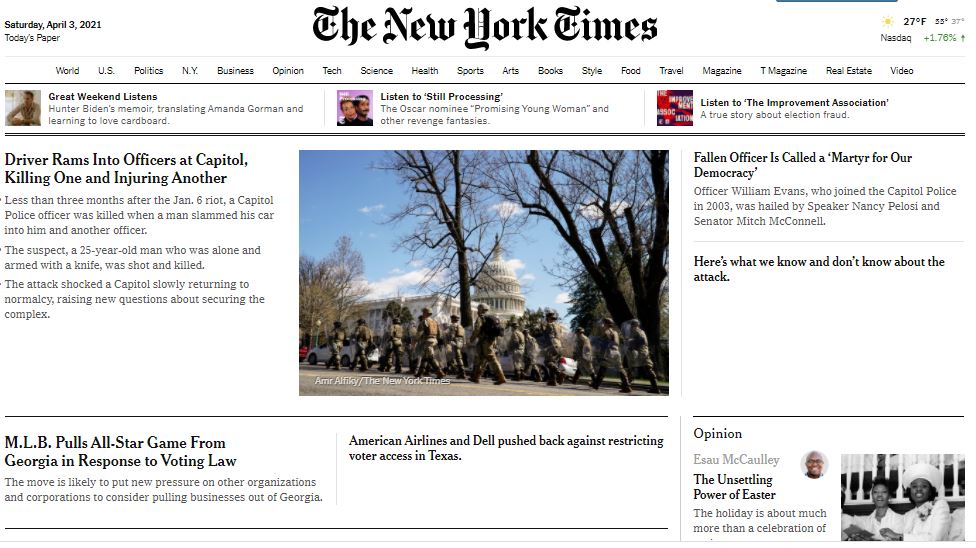New York Times Style Change?
A subtle but odd change in house style for the Paper of Record
As regular readers may have noted, I tend to cite the on-page headlines of stories that I link. This morning, I’ve noted something peculiar about headlines from the New York Times: an ending period.
Here’s the front page of their website:

There, we see inconsistency. Some headlines have a period, while others are period-free. (If one scrolls down, some end in a question mark, which is more typical.) There seems no rhyme or reason. “The Unsettling Power of Easter” rightly has no period since it’s not a complete sentence. Then again, “M.L.B. Pulls All-Star Game From Georgia in Response to Voting Law” is a complete sentence and similarly lacks a period. Ditto “Fallen Officer is Called a ‘Martyr for Democracy.’ And, most weirdly “Here’s what we know and don’t know about the attack” isn’t really a complete sentence but not only has a period but is written in sentence case rather than title case. The only explanation I can conjure is that most of the ones that don’t end in a period are followed by a subhed that does have a period.
This likely interests no one but me but I find the change, for which I can find no posted explanation, odd.






That looks to me to be correct. It looks like it fits all 5 examples.
They changed the page layout as well. For example, the list of opinion pieces no longer appears in a vertical sort-of sidebar near the top. Instead they’re gathered into a horizontal structure much farther down.
I pay at least passing attention because I have a piece of JavaScript that runs on almost every page I download, forcing the text into my preferred fonts (Noto Serif for proportional, Courier New for monospaced) and a limited number of sizes. The generic handler is not bad, but I’ve added some fine-tuning for sites I visit regularly. The NYTimes formatting is quite inconsistent: some headlines are tagged as paragraphs, some as headings, some simply as divisions, with lots of styles used to force more appropriate appearances.
Between ad blocking and reformatting, my view of the web is quite different than most people experience. I started writing the JavaScript on a day when I encountered more pages than usual where I wanted to ask the designer, “Did you study ugly and unreadable formally, or are you just naturally talented?”
@Michael Cain: 25 years after I first started using the Internet and I still can’t consistently get webpages to display a minimum font size and consistent font. I had a greasemonkey script that worked about 90% of the time but now that I’m on this iPad it’s very inconsistent.
If I were a dictator, anybody who put text on the web in less than 12 point font, or put text in light gray against a bright white background, would see serious prison time.
Being 5 weeks past the 2nd dose, I likely don’t need to mask, but do, as a courtesy to others who are not yet able to receive the shot and have no idea that I have.
@Teve: I do much better than 90%, but some of that is because sanity broke out at the W3C a few years back and they changed the styling priority rules. Now that styles attached directly to an element take precedence over everything else (except !important), getting changes to “take” is much easier.
???
In what way is that not a complete sentence? What’s missing? You didn’t bat an eye at the headlinese examples that are clearly lacking articles, but this one tripped you? I’m confused.
@DrDaveT: It strikes me as an introductory clause that should be followed by a colon and a list.
@James Joyner:
OK, I can see that.
It seems like the ones with periods are the ones without excerpts.
In other words, there is either a period at the end of the excerpt or at the end of the title for the ones without further text.
@Steven L. Taylor: Yes, that seems to be it. Quite odd, really. I prefer title case and headline form for my headlines.